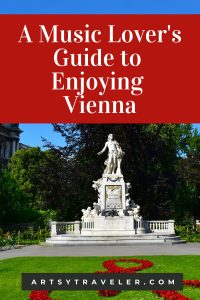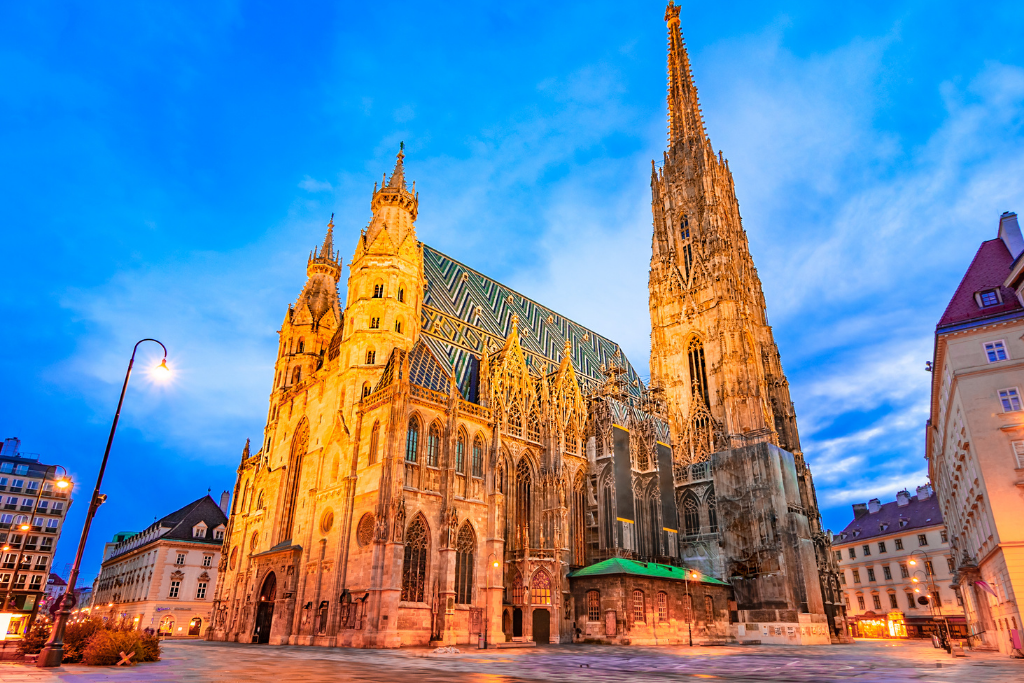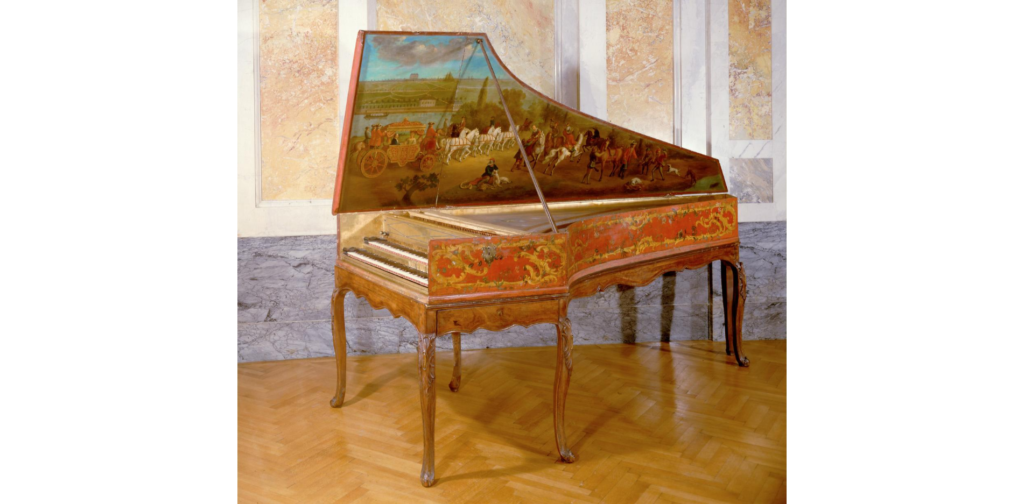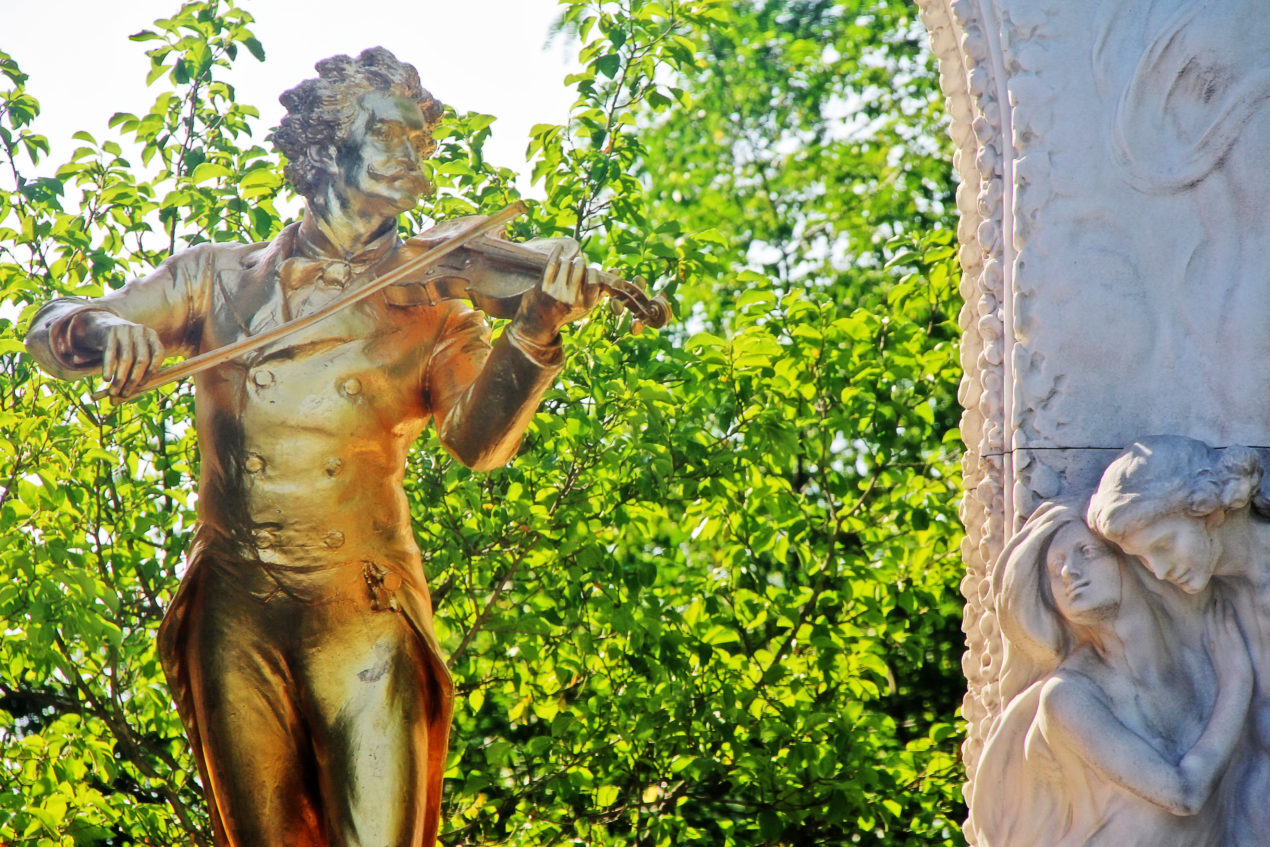A Music Lover’s Guide to Enjoying Music in Vienna
If you love music, you owe it to yourself to plan a trip to Vienna in Austria. For over 250 years, this great city has celebrated and enjoyed its reputation as the City of Music. And no wonder!
Many of Europe’s greatest composers, including Haydn, Beethoven, Mozart, Schubert, and Strauss, lived and worked in Vienna. When you visit Vienna today, you’ll see evidence everywhere of the city’s illustrious musical past.
In this post, I describe options for enjoying music in Vienna, including music museums, composers’ houses, and concerts.

Vienna Music at a Glance
- Best music museum: House of Music
- Best composer museums: Beethoven Museum and Mozarthaus
- Best small concert venue: Sala Terrena
- Best music concert tour: Schoenbrunn
Vienna and Music
Hang out in the central square (Stephansplatz) near the imposing St. Stephen’s Cathedral, and within minutes, a young person dressed in 18th-century garb will hand you a flyer advertising the music concerts on offer.
Go for a walk in any park and you’ll soon be snapping selfies in front of statues of composers.

In the evening, wander the cobbled streets in the center of the city and you’ll hear snatches of melodies from chamber music and full orchestras wafting into the soft air from concert venues specializing in tourist-oriented programs usually dominated by the music of Mozart and Strauss.
A Map of Musical Vienna
The map below shows the location of all the music sites mentioned in this post. Vienna is a very walkable city. You can easily stroll between most of the sites in central Vienna and still have energy left to enjoy a coffee, a slice of torte, and a spot of people watching.
I recommend starting at the House of Music (#1) and venturing out from there to visit the museums dedicated to your fave composers, and then spend the evening enjoying a concert.
Music Museums in Vienna
Vienna is chock-a-block with excellent museums. I’m a bit of a museum fan girl, so for me, this city ranks as one of Europe’s top museum cities. You could easily spend a week here and not run out of world-class museums to visit.
In this post, I focus on two of my favorite music museums: the House of Music and the Musical Instrument Museum, which is part of the Kunsthistorisches Museum.
House of Music
Make time for a visit to the House of Music, (#1 on the map above) also known as Vienna’s Museum of Sound or Haus der Musik.
Housed in the historical palace of Archduke Karl in the old city center, this museum is a must-see for everyone. And it is absolute heaven for music lovers.
On a recent trip, I spent half a day there enjoying its five floors (yes, five!) of installations and displays celebrating music and sound. Trust me, you won’t want to miss this place.
Highlights of the House of Music
Here are some highlights at the House of Music.
Virtostage
This is a multimedia and interactive production. When you move in front of the screen, you become part of the 15-minute opera “zeitperlen”. Members of the Vienna Philharmonic Orchestra recorded the music with vocals by opera star Natalia Ushakova. Technically and musically, the production is a remarkable achievement.
NAMADEUS
Namadeus is an installation created after Mozart’s musical game KV 516f. Included are the interactive Waltz Dice Game and an interactive application called Facing Mozart that lets you bring the composer’s portrait to life by controlling his head movements and facial expressions. Hours of fun!
Virtual Conductor
This installation allows you to “conduct” a video projection of the orchestra that responds to your conducting commands. If you conduct poorly, the musicians respond with criticism, so you need to keep time correctly!
Sound installations
These installations use state-of-the-art technology, including opportunities to visualize sound as waves, swirls, and grids.
Exhibits at the House of Music
The museum includes gloriously comprehensive exhibits of composers including Beethoven, Mozart, Haydn, Strauss, and Mahler. I spent at least an hour in this section. Plenty of life-size figures and original musical instruments bring the subjects to life.
I especially enjoyed the Haydn portion of the exhibition.
During his long life, Papa Haydn exerted enormous influence on classical music. He even counted Beethoven and Mozart among his many pupils.
Haydn had a complicated relationship with Beethoven who criticized his teacher by saying “I never learned anything from Haydn” and then dedicated his set of three Piano Sonatas Opus 2 to Haydn. (reference: Beethoven and Haydn: their relationship)
The House of Music is located at Seilerstätte 30 in Vienna and you can get a discount with the Vienna City Card. The museum is open daily from 10 am to 10 pm.
You can also purchase tickets through GetYourGuide. If you love music, you really can’t miss the House of Music, aka Haus der Musik!
Musical Instrument Museum
I always enjoy touring a good musical instrument museum, and this one is first-rate. Housed in the Hofburg Palace and part of the masive Kunsthistorisches Museum, the Musical Instrument Museum (#2 on the map above) exhibits five centuries of historical musical instruments. Its collection of Renaissance and Baroque instruments is considered one of the most important in the world.
You’ll see a particularly awesome collection of clavichords and Viennese fortepianos. A highlight for me was seeing pianos that had been played by Mozart, Liszt, Mahler, and Clara Schumann, who is the inspiration for my second novel, A Woman of Note.

The museum also includes replicas of historical instruments that visitors may play, and regularly holds concerts at which master interpreters of their professions play the original instruments.
The Musical Instrument Museum is located at Heldenplatz and is open daily except Wednesday from 10 am to 6 pm.
Composer Houses
Many of the apartments lived in by famous composers have been converted into museums. Download a map of Musician Walks from the excellent Wien Info website.
Here is information (in alphabetical order) about the museums dedicated to individual composers including Beethoven, Haydn, Mozart, Schönberg, Schubert, and Strauss. Some of them are celebrated in more than one museum.
You can visit the six apartments of Beethoven, Strauss, Schubert, and Haydn with a special combination ticket from the Wien Museum website. Note that most of the museums close on Mondays.
Ludwig von Beethoven
Beethoven House
I’ve made two pilgrimages to the Pasqualati House (#3 on the map above), one of the many houses in which the great composer lived. Built in the 18th century adjacent to the city walls, the house is named after its owner (Pasqualati). Beethoven lived for eight years, off and on, in the 4th floor apartment at the top of a series of old stone staircases.
During my second visit to the apartment, I was writing A Woman of Note about a woman composer in 1830s Vienna. The novel starts with the funeral of Beethoven, and his influence is felt by the characters throughout the novel. As I mounted the old staircase to Beethoven’s apartment, I imagined my characters mounting similar staircases in buildings of the same vintage.
When I visited, the apartment was virtually bare of furniture and contained little in the way of exhibits. Two listening desks are set up for listening to various Beethoven pieces on headphones.
I indulged myself with the second movement of Symphony No. 7 for a while. I was the only visitor, so it was just me and the Maestro’s soaring melodies and the temptation to burst into tears.
Musical tourism doesn’t get any better.

Beethoven Museum
Want more Beethoven? Visit the Beethoven Museum (#4).
In 2017, the original 40-square-meter apartment at Probusgasse 6 in Heiligenstadt in the 19th district where Beethoven lived was extended to create a spacious, 14-room museum. Here you’ll find exhibits chronicling the history of the house, Beethoven’s move from Bonn to Vienna, his stay in Heiligenstadt, and many more related to the maestro.
Pasqualati House (or Pasqualatihaus) is located at Mölker Bastei 8 in Vienna and is open Tuesday to Sunday from 10 am to 1 pm and from 2 pm to 6 pm except for public holidays. The Beethoven Museum is located at Probusgasse 6 and is also open Tuesday to Sunday from 10 am to 1 pm and from 2 pm to 6 pm except for public holidays.
Joseph Haydn
Haydnhaus
Managed by the Wien Museum (as are most of the composer houses), Haydnhaus (#5) is the location where Joseph Haydn spent the last twelve years of his life and where he died on May 31, 1809. The museum includes the rooms of his flat on the first floor, recently restored so that the rooms are divided in the same way they were when he lived there.
Haydn was extremely famous during his lifetime, and exhibits at the museum reflect the esteem in which he was held both then and now.
The museum also has a room dedicated to Brahms.
Haydnhaus is located at Haydngasse 19 and is open Tuesday to Sunday from 10 am to 1 pm and from 2 pm to 6 pm except for public holidays.
Wolfgang Amadeus Mozart
Mozarthaus Museum
Mozart lived in several houses in the city during his short and tumultuous life. The only one that survives is the Mozarthaus Museum (#6) at Domgasse #5, where he lived from 1784 to 1787.
Occupying 1,000 square meters on six levels, this museum is the premier pilgrimage site for Mozart fans.
And seriously, who isn’t a Mozart fan?
The museum immerses you in the great composer’s world. Exhibits celebrate his remarkable genius and creativity and feature his family, friends, and foes in the heady world of late-Baroque Vienna. Get tickets here.
Mozarthaus is located in St. Stephansplatz at Domgasse 5 and is open Tuesday to Sunday from 10 am to 6 pm except for public holidays.
Arnold Schönberg
Arnold Schönberg Center
Established in 1998, the Arnold Schönberg Center (#7) celebrates and life and work of one of the 20th century’s most notable composers (and also a painter, teacher, theoretician, and innovator). If you’re a music history buff, you’ll know that Schönberg is associated with the method of composing with the 12-tone scale.
The museum includes exhibitions about Schönberg’s life, a gallery of his paintings, a replica of his study in Los Angeles, the city in which he died in 1951, and lots of concerts, lectures, and other events aimed at helping people understand and enjoy Schönberg’s music.
The Arnold Schönberg Center is located at St. Stephansplatz at Schwarzenbergplatz 6 and is open Monday to Friday from 9 am to 5 pm except for holidays.
Franz Schubert
I’m very fond of Schubert, who makes a cameo appears in A Woman of Note and who, like Mozart, died very young (he was just 31). He managed to compose an amazing amount of music in his short lifetime, much of it lived in poverty. Two museums in Vienna are devoted to Schubert.
Schubert Geburtshaus
The Schubert Geburtshaus (#8) is the house where he was born on January 31, 1797. He came from a large family that shared one room and a kitchen with an open fire. The exhibits include a pair of spectacles that belonged to Schubert and has apparently become quite an object of veneration for his fans.
Schubert Sterbewohnung
Schubert died at the Schubert Sterbewohnung (#9) on November 19, 1828. Although he lived in the small apartment for only a few weeks, he composed several works including the song “The Shepherd on the Rock.” Exhibits document the last weeks of his life, his death, and his funeral.
Schubert Geburtshaus is located at Nußdorfer Straße 54 and is open Tuesday to Sunday from 10 am to 1 pm and 2 pm to 6 pm except for public holidays and Schubert Sterbewohnung is located at Kettenbrückengasse 6 and is open Tuesday to Sunday from to 10 am to pm and 2 pm to 6 pm except for public holidays.
Johann Strauss
Johann Strauss Wohnung
The Johann Strauss Wohnung museum (#10) is the apartment where the composer wrote “The Blue Danube” waltz which has become Austria’s unofficial national anthem. The museum includes his instruments along with furniture and paintings from his life, and references to the other musical members of the Strauss dynasty.
Strauss Museum
This new museum (it opened in 2015) is dedicated to the lives and work of the composers in the Strauss family, It’s a must-see for Strauss fans. Find pictures and documents from the period and listen to music at the various audio stations arranged in 15 themed areas. Here’s a detailed post about the museum on the Visiting Vienna website.
Johann Strauss Wohnung is located at Praterstraße 54 and is open Tuesday to Sunday from 10 am 1 pm and 2 pm to 6 pm except for public holidays. The Strauss Museum is to remain closed through 2021 and will reopen in 2022 at a new location.
Vienna Concerts
You can’t walk far without seeing ads for music concerts, particularly those organized for tourists and, as mentioned earlier, mostly featuring music by Mozart and Strauss (and occasionally Beethoven, Schubert, and Haydn). Check the current concert listings.
If you’re lucky, you might get to catch a performance by the Vienna Boys Choir, an opera at the opera house, or a performance by the Vienna Philharmonic (Wiener Philharmoniker). Following are descriptions of two concerts I enjoyed during a recent trip.
Find concert listings on the Vienna Sightseeing website.
Classical Music Concert at the Sala Terrena
The Sala Terrena (#11) is a small concert hall next to a monastery in the centre of Vienna. Mozart lived in the building for about two months when he first came to the city as a young man. The room is frescoed from floor to ceiling with a cacophony of Italian Baroque splendor. You’ll see lots of fruit, cherubs, roses, urns, and even a leopard.
I chose the Sala Terrena concert rather than one of the flashier tourist concerts because Schubert was on the programme. Schubert makes a guest appearance in A Woman of Note, so I owed it to my imagination to hear his music played at least once in his home town.
Alas, ‘twas not to be. The programme was changed to include the American Quartet by Dvorak and some Hadyn string quartets. Fortunately, the performances were fantastic, so I had no complaints.
Concert Experience
Four musicians dressed in 18th-century garb (someone in this city must do a roaring trade in producing period costumes) entered the tiny salon and settled in to play. Unfortunately, as so often happens when I attend an evening concert soon after landing in Europe, jet lag hit me with a vengeance. I was seated in the front row, directly in the line of sight of the first violinist.
Despite my best efforts, my eyelids drooped, and my head started that awful bobbing thing that happens when you desperately fight falling asleep. What if I pitched face-first into the violinist’s lap? She might not appreciate the interruption.
In my defense, I defy any jet-lagged music lover to sit through an adagio without succumbing to the temptation to close one’s eyes and drift. In the intermission, I chatted with a young woman from Japan who was studying art in Florence. I love how traveling can connect you with people, including local artists and artisans, from all over the world.
The concert was a success, and I drifted out into the heaving mass of tourists and locals thronging the Stephansplatz. If I hadn’t been alone, I would have hung around for awhile to enjoy a slice of strudel and a glass of wine in the shadow of the floodlit cathedral. Instead, I let the atmosphere wash over me for about ten minutes and then caught the tram back to my apartment.
You can book tickets to a concert at the Sala Terrena below. The title says the Mozarthaus, but the concerts are the ones held in the Sala Terrena that I attended. Highly recommended!
Concert at the Schloss Laudon
While I was in Vienna, I was determined to see a “real” concert. By real, I mean a concert that does not feature costumed musicians and Eine Kleine Nachtmusik (not that there’s anything wrong with that). But I wanted to attend a concert with local people.
Fortunately, I discovered that the five-day Schloss Laudon festival—a yearly classical music event held in the salon at the Schloss Laudon (#12), also known as the Water Palace about an hour outside of the city —was on during my visit.
Getting to Schloss Laudon
With e-ticket in hand, I boarded the metro for a ride to the last stop. For forty minutes, the bus wound through a maze of suburban streets toward what I hoped would be the palace.
I had absolutely no clue where I was and what I’d do if I was on the wrong bus (I didn’t have a Smartphone with GPS at the time). What if there was no concert at the end of the ride and no bus back? I’d be stranded miles from nowhere with only 60 euros in my wallet and a pathological fear of incurring data roaming charges on my phone because on that trip I hadn’t had the foresight to buy a European SIM card.
Update note: Thank goodness you can now conveniently buy an eSIM card for traveling anywhere in Europe!
Fortunately, I heard a couple on the bus mention Schloss Laudon, and minutes later the bus stopped and they got off.
I followed.
Exploring Schloss Laudon
The Schloss Laudon and its stylishly landscaped grounds were exquisite. I was extremely early for the concert but fortunately not for the bar. I sipped a glass of wine while wandering the sylvan pathways and making friends with the swans.

Experiencing the Concert at Schloss Laudon
The concert featured a trio – piano, violin, and cello—in the large salon in the Schloss Laudon. A Schloss is basically a palace or a castle, and this place certainly qualified. The salon was frescoed floor to ceiling with exotic animals (tigers, rhinos, elephants, etc.) and exotic scenes of idealized, vaguely New World native-looking people in turbans. Evidently, historical accuracy was not a priority.
I snagged a seat in the second row, in direct line of sight of the keyboard. As a pianist myself, I always like to get as close to the keyboard as possible so I can watch the performer’s hands.
Almost everyone around me was dressed to the nines. Most of the men wore suits and ties, and the women wore cocktail dresses and lots of jewelry and perfume. I might as well have had a neon sign on my head – turista. But whatever.
No one paid any attention to me—not even a wee smile of musical comradeship. I felt a tad isolated, but what could I expect? Solitary travel can sometimes be a bit, ah, solitary.
A drawback of sitting in the second row quickly became apparent. The large spotlight caught me in its glare, and soon I was sweating. The heat would have been tolerable if indeed there had been music to listen to. However, to my dismay, the festival director and an expert on the modern composer featured on the program both shuffled to the front and faced the audience.
The Pre-Concert Talk
Festival-Director Guy talked for about five minutes–a bearable length of time to listen to German and pretend to understand. Then, Composer-Expert Guy took over and talked for at least thirty minutes.
He stood directly in front of me, even making eye contact occasionally, so I had to look as if I was hanging on his every German syllable. I caught a few words—Mexico, Nazis, Anschluss, Franco. I snuck a peek at the concert notes–in German, of course and managed to decipher that the composer of the modern piece had left Vienna in 1938 and settled in Mexico by way of Spain.
That was not a whole lot of information to get from a thirty-minute lecture.
Haydn & Tchaikovsky
Finally, the three musicians entered and performed an early Beethoven piano trio in the style of Haydn. The heat, the somnolence engendered by Composer-Expert Guy’s talk, and those darned slow movements marred my enjoyment of the piece.
Again, I experienced more than a few head bobs along with the terror that someone might notice. What if I snored or drooled? After the Beethoven came the modern composer’s piece, which was actually pretty good in a dissonant, modern music kind of way.
At the break, I thought about giving in to jet lag and catching the bus back to the metro. I even walked out to the bus stop and checked the times. Then I came to my senses and trudged back into the palace for the second half—the piano trio by Tchaikovsky.
Holy Russian romantic! It was stunning—no danger of head-bobbing for this one. I cheerfully bought the CD.
Exploring Vienna
Here are some GetYourGuide tours in Vienna.
Vienna Walking Tours
GuruWalk lists pay-what-you-please walking tours that connect tourists with tour guides all around the world. Check out their tours of Vienna!
Concerts at Schoenbrunn Palace
For a wonderful classical music experience that throws in a world-class palace for good measure, consider going to a concert at Schoenbrunn Palace. The repertoire leans heavily to Strauss and Mozart with performances by opera singers. If you take a tour, you’ll often also get dinner and drinks, along with priority entrance to the palace.
Here are some GetYourGuide tours that will take you to concerts at Schoenbrunn Palace.
Where to Stay in Vienna
Vienna is not an inexpensive city, but if you can swing it, stay as close to the center as you can afford.
On my first trip to Vienna, I made the mistake of staying waaaaay out in the suburbs in a cheap apartment. Well, let’s just say that it was a disaster! After two days of cramped quarters, cold water showers, bland suburbs that could be anywhere, and long commutes into Vienna, we moved to a hotel close to the action. The extra money was well worth it.
I learned my lesson and now I value comfort and convenience over penny pinching every time!
Here are some hotels in the center of Vienna with +9 ratings on booking.com that offer good value:
- House of Ble: Close to the Kunsthistoriches and Natural History Museums; stylish and modern
- Apartement-Hotel an der Riemergasse: Located in a restored Art Nouveau building close to St. Stephen’s Cathedral
- Hotel Kaiserin Elisabeth: Relatively spacious rooms very close to St. Stephen’s Cathedral.
Conclusion
Vienna, the City of Music, is a must-see for the artsy traveler who loves classical music. You can’t help but swoon when you walk into your favorite composer’s house, or when you hear a Strauss waltz played in the city where it was composed, or explore the awesome exhibits at the House of Music.
And when you want a break from music (why?!), Vienna has some of the best art museums in the world, including the Belvedere where you’ll see Klimt’s The Kiss and the always amazing Kunsthistorisches Museum.
For more information about what to see and do in Vienna and Austria, check out these posts
- Visit These 15 Best Museums in Vienna
- Visit Vienna & Salzburg: Best Tips for Artsy Sightseeing
- Novels Set in Austria Perfect for the Artsy Traveler
Have you visited any of the music sites in Vienna described in this post? Share your thoughts about music and Vienna with other artsy travelers in the Comments section below.
